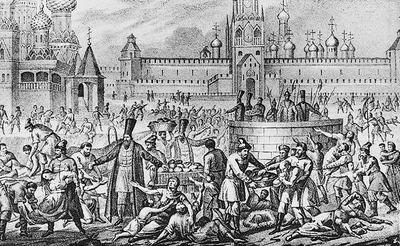You can help expand this article with text translated from the corresponding article in Russian. (December 2023) Click [show] for important translation instructions.
|
The Russian famine of 1601–1603, Russia's worst famine in terms of proportional effect on the population, killed perhaps two million people: about 30% of the Russian people. The famine compounded the Time of Troubles (1598–1613), when the Tsardom of Russia was unsettled politically and later invaded (1605–1618) by the Polish–Lithuanian Commonwealth. The many deaths contributed to social disruption. The famine resulted from a volcanic winter, a series of worldwide record cold winters and crop disruption, which geologists in 2008 linked to the 1600 volcanic eruption of Huaynaputina in Peru.[1][2]

Causes
editA 2008 study by Kenneth L. Verosub and Jake Lippman documents worldwide famine after the eruption of a volcano in Peru in 1600.[3] Huaynaputina ejected 16 to 32 million metric tons of particulates into the atmosphere, notably sulfur dioxide, forming sulfuric acid and creating a volcanic winter; this reduced the amount of sunlight reaching the Earth's surface (see Albedo), which scientists believe contributed to bitterly cold winters, loss of crops and animals, and massive famine around the world. As a result, people killed many animals with their bare hands to preserve their furs for warmth.[4][5][6]
The famine was documented across the world: "Records from Switzerland, Latvia and Estonia record exceptionally cold winters in 1600–1602; in France, the 1601 wine harvest was late, and wine production collapsed in Germany and Colonial Peru. In China, peach trees bloomed late, and Lake Suwa in Japan had one of its earliest freezing dates in 500 years."[4]
Famine
editFollowing the poor harvest of 1601 the prices of grain doubled reaching 60-70 kopecks per quarter of rye. In the next year many peasants did not have enough seeds to sow the fields and by fall the prices grew to 3 rubles per quarter. The weather in 1603 was fine but many fields were empty and thus the famine intensified.[7]
Boris Godunov's government attempted unsuccessfully to help the people by selling grain from state granaries at half price and later by giving away grain and money to the poor in the major cities until the treasury was depleted.[7] During this two-and-a-half-year period, 127,000 bodies were buried in mass graves in Moscow alone. According to a witness "one third of the Muscovite Tsardom perished from the famine."[7]
Effects
editThe suffering and social disruption were part of the political unrest called the Time of Troubles.[4] Petty gentry were hurt by the famine as badly as peasants and many were forced to sell themselves into slavery, joining the armed retinues of magnates. Others migrated to the steppe frontier and joined Cossacks, as did many runaway serfs. A large number of trained and armed individuals in the southern regions formed a large manpower pool which was tapped by multiple ensuing insurgencies.[7]
See also
editReferences
edit- ^ Perkins, S. (2009). "Disaster goes global: The eruption in 1600 of a seemingly quiet volcano in peru changed global climate and triggered famine as far away as Russia". Science News. 174 (5): 16–21. doi:10.1002/scin.2008.5591740519.
- ^ University of California – Davis (25 April 2008). "Volcanic Eruption of 1600 Caused Global Disruption". ScienceDaily.
- ^ Verosub, K. L.; Lippman, J. (2008). "Global Impacts of the 1600's Eruption of Peru's Huaynaputina Volcano". Eos, Transactions American Geophysical Union. 89 (15): 141. Bibcode:2008EOSTr..89..141V. doi:10.1029/2008EO150001.
- ^ a b c "1600 Eruption Caused Global Disruption". Geology Times. Archived from the original on 3 March 2016.
- ^ Andrea Thompson, "Volcano in 1600 caused global disruption", MSNBC.com, 5 May 2008, accessed 13 November 2010.
- ^ "The 1600 eruption of Huaynaputina in Peru caused global disruption" Archived 28 April 2010 at the Wayback Machine, Science Centric.
- ^ a b c d Turchin, Peter (2009). Secular Cycles. Princeton University Press. pp. 256–257. ISBN 9780691136967.